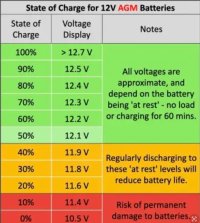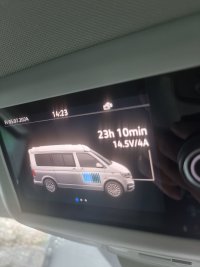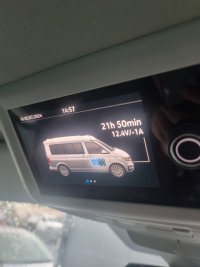A
AussieCaliBeach
Hi all,
I have a 2021 Cali Beach T6.1 and neither of my batteries will charge higher than 65%. I only noticed something was not right camping last weekend when my diesel heater kept turning off after 20 minutes though the battery panel was still showing around 20%. Looking at the Leisure battery display it shows it at a maximum of roughly 70% following a long drive, charging at 2amps at that point where it just seems to sit at 70%-ish. A local battery store helped me with a battery test, figures below.
Engine
Voltage: 12.35 V
Rated: 800 CCA/SAE
Measured: 767 CCA/SAE
IR: 3.22 mAmps
State of Charge: 54%
State of Health: 96%
Leisure
Voltage: 12.47 V
Rated: 800 CCA/SAE
Measured: 746 CCA/SAE
IR: 3.31 mAmps
State of Charge: 64%
State of Health: 93%
Unfortunately, my local service center has a 1.5 month wait time to get in and the techs are very inexperienced with Californias. I was wondering if anyone had some self-check tips I could try to start working out the issue. As a full disclosure, I am not very technical so somewhat simple explanations would be most helpful. Cheers for any help!
I have a 2021 Cali Beach T6.1 and neither of my batteries will charge higher than 65%. I only noticed something was not right camping last weekend when my diesel heater kept turning off after 20 minutes though the battery panel was still showing around 20%. Looking at the Leisure battery display it shows it at a maximum of roughly 70% following a long drive, charging at 2amps at that point where it just seems to sit at 70%-ish. A local battery store helped me with a battery test, figures below.
Engine
Voltage: 12.35 V
Rated: 800 CCA/SAE
Measured: 767 CCA/SAE
IR: 3.22 mAmps
State of Charge: 54%
State of Health: 96%
Leisure
Voltage: 12.47 V
Rated: 800 CCA/SAE
Measured: 746 CCA/SAE
IR: 3.31 mAmps
State of Charge: 64%
State of Health: 93%
Unfortunately, my local service center has a 1.5 month wait time to get in and the techs are very inexperienced with Californias. I was wondering if anyone had some self-check tips I could try to start working out the issue. As a full disclosure, I am not very technical so somewhat simple explanations would be most helpful. Cheers for any help!
















